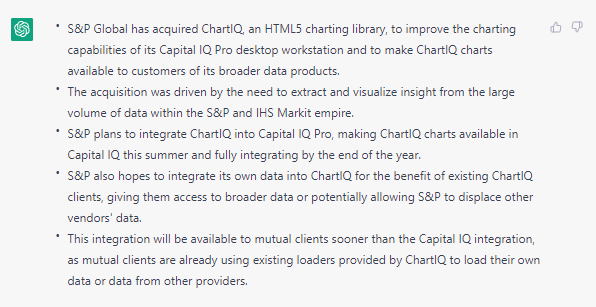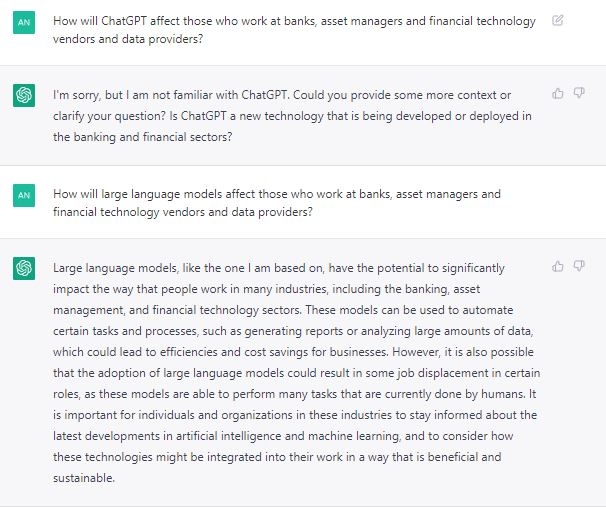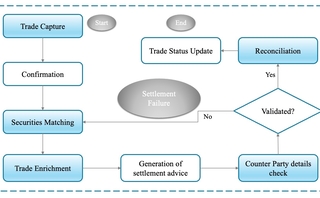Waters Wrap: ChatGPT and the next wave of AI evolution
As the December holiday break loomed, a new tool released by OpenAI had engineers, analysts, programmers and even writers like Anthony wondering what the future of their professions might hold.

Need to know
Since the release of ChatGPT, excitement and hype have been abundant across industries for this form of generative AI. For capital markets, the wave of innovation that could result may be a few years away but it’s worth paying attention to—and being critical of. Click here for a deep-dive into what this wave might bring.
My first real job after graduating from Plattsburgh State University was as a sports reporter at The Journal News in White Plains, New York, which is about a 35-minute train trip north of Midtown Manhattan. While I covered the occasional professional sporting event, 95% of my time was spent chronicling the local high school/amateur sports scene—from football to gymnastics, baseball to track, basketball to wrestling and even yacht racing…don’t get me started on that last one.
Even though I’m a sports fan, I quickly grew tired of writing about sports—someone won, someone lost…who gives a shit? But the part I hated most was compiling information for the “sports agate”. You can read this funny column about what an agate is, but in old-school newspaper parlance, it is (was) basically a page of box scores, gambling spreads, horse racing results, among many other things. For every high school sporting event in the region, us junior sports reporters would take calls from about 6 pm until midnight and enter stats from those events into a third-party CMS. From there, using those numbers, we had to write a few sentences about the game/meet/match/whatever:
The undefeated Carmel Rams beat the Mahopac Indians 42-0 in the final game of the regular season. Jeff Enkler threw for 302 yards, with four touchdown passes and no interceptions. Jory Marvel caught two of those touchdowns. The Rams will next play at home versus the Pawling Tigers (5-3) in the first round of the playoffs on Saturday, Nov 20.
It was tedious and soul-sucking work, to say the least, so I quit and became a reporter covering the financial markets. But a few years after I left, apparently, they started using an app that would automatically generate that text based off the stats provided in the agate.
This is AI at its best—take manual, tedious tasks, and allow a bot or AI agent to do that work for you, thus allowing (in this case) the reporters to focus on higher-value coverage of the local sports scene. Now, some people were likely laid off (though I have no clue for sure in this specific case) because the company didn’t need as many humans to fill out this portion of the newspaper. But to be honest, if this “work” was the best of your abilities and desires, journalism was probably not for you, anyway.
That last sentence might seem a bit arrogant—probably because I am arrogant. But I also never thought that AI could replace what I do as a reporter: cultivate trusted sources, find out information others don’t know, contextualize trends and present that in an easily digestible format. (Regular readers of this column might argue with my abilities to do that last piece…and buckle in, because I ain’t close to done writing.)
While I’m still secure that AI isn’t taking my job anytime soon, as I started playing around with ChatGPT during the holiday break, a shiver did go down my spine.
ChatGPT is a chatbot developed by OpenAI. I’ll let the fine folks at Wired take it from there:
“[The] AI at the core of ChatGPT is not, in fact, very new. It is a version of an AI model called GPT-3 that generates text based on patterns it digested from huge quantities of text gathered from the web. That model, which is available as a commercial API for programmers, has already shown that it can answer questions and generate text very well some of the time. But getting the service to respond in a particular way required crafting the right prompt to feed into the software. ChatGPT stands out because it can take a naturally phrased question and answer it using a new variant of GPT-3, called GPT-3.5. This tweak has unlocked a new capacity to respond to all kinds of questions, giving the powerful AI model a compelling new interface just about anyone can use. That OpenAI has thrown open the service for free, and the fact that its glitches can be good fun, also helped fuel the chatbot’s viral debut—similar to how some tools for creating images using AI have proven ideal for meme-making.”
Now, as that Wired article goes on to explain, the tool is still quite flawed and inaccurate. This is the early days of this particular stage of chatbot evolution, but it does represent an impressive jump in progress for machine learning (ML) and natural language processing (NLP).
Here’s how a machine-learning engineer at a very large financial data and technology provider put it to me: “LLMs (large language models, which is what GPT-3 is) are hard to scale and they’re really, really expensive. And you’re basically boiling the ocean to make these models—[there are] trillions of parameters in the model. There are all sorts of custom hardware being built to run them right now. But they do represent a significant leap in technology.”
The engineer has been playing around with ChatGPT. They’re quick to point out that results are, at times, inaccurate, so you have to be very careful when it comes to actually relying on the chatbot’s outputs—right now, it’s best for experimentation. With that being said, the engineer is impressed with what it can already do at this stage.
“For things like, ‘Sort an array of 100 elements in the most optimal way,’ it will figure it out. But if you say, ‘Invent me a new content management system,’—no. Garbage in, garbage out—you have to be specific and realistic in what you’re asking it for. But you can paste a LeetCode question into it and for a vast majority of them, the bot can provide you an accurate answer,” they say.
“You can take these questions and pop them into ChatGPT and it can solve a good chunk of them. It does fuck them up sometimes, so you need to be very conscious of that.”
Another engineer friend of mine says that while they haven’t used it for coding—though, apparently, you can—they have used it to help, for example, answer questions about managing cloud infrastructure.
“‘If I set this default value on this shared cloud service using this tool, will it affect only me or will it affect other users of that service?’,” they asked it. “I wanted to make sure I wasn’t going to fuck anything up for anyone else, and I didn’t want to go sifting through the documentation. It was useful for that, but you have to be careful what you believe. It was also good for helping me do some end-of-year bullshit—I asked it something like, what are the five pillars of the business security risk model, or whatever. It was perfect for that.”
Others have wondered about the future of their jobs. I texted an analyst at an ESG research provider if they were worried about this latest evolution, and they wrote back: “Oh yeah, I’m done for. Already, I can get it to write like me—game over, lol.” Now, they were being a bit facetious, but it’s a question that did cross their head once they started experimenting with the new platform.
The question has crossed my mind, as well. AI can create beautiful, award-winning works of art. Some are experimenting with AI to rewrite novels. AI can be helpful, but the eternal question is—can it become too powerful and replace us humans? Hell, might that even be a good thing for humans—a world without work?
To play around with the tools, I fed a recent story that Max Bowie wrote about S&P Global buying ChartIQ into ChatGPT and asked it, “Can you summarize this story in five bullet points?”. It produced this:

Honestly, it did a damn good job.
I then put in a press release about a partnership between Nasdaq and a Chilean exchange, and told it to “summarize this press release in four sentences, don’t use quotes from individuals.”
It spit out this:
Nasdaq and Bolsa Electrónica de Chile (BEC) have announced an agreement in which BEC will upgrade to Nasdaq’s Marketplace Services Platform, with the aim of moving its operations to the cloud by the end of 2024. BEC will be the first company to adopt a full cloud migration strategy in Latin America. The partnership builds on a decade-long relationship between the two companies. Nasdaq’s Marketplace Services Platform allows exchanges around the world to retain the functionality of its on-premise technology, with the added benefits of enhanced scalability and agility provided by cloud-enabled environments. BEC’s migration to Nasdaq’s SaaS-based matching service is expected in late 2024.
Honestly, it’s quite PR-y (as you’d expect) and doesn’t do any fact checking, but it definitely got the gist and pulled out most of the most important pieces.
Do I think that ChatGPT is going to replace my job? No. It’s a tool. It can be a useful tool. But what it does show is that you need to keep on experimenting with new technologies, and you, as a human, need to continually work on improving your skillset for your chosen profession.
We’re going to look into how this latest evolution in LLMs could affect those that work in trading technology and data…it’s still early days, but we want to better understand what areas could be disrupted, both for better and worse. If you have thoughts, please do hit me up by emailing me at anthony.malakian@infopro-digital.com. Or, maybe just ask ChatGPT, “How will ChatGPT affect those who work at banks, asset managers and financial technology vendors and data providers?”

Dumbass doesn’t even know its own name. We’re safe…for now.
The image accompanying this column is “The Death of Socrates” by Jacques Louis David French, courtesy of The Met’s open-access program.
Further reading
Only users who have a paid subscription or are part of a corporate subscription are able to print or copy content.
To access these options, along with all other subscription benefits, please contact info@waterstechnology.com or view our subscription options here: http://subscriptions.waterstechnology.com/subscribe
You are currently unable to print this content. Please contact info@waterstechnology.com to find out more.
You are currently unable to copy this content. Please contact info@waterstechnology.com to find out more.
Copyright Infopro Digital Limited. All rights reserved.
You may share this content using our article tools. Printing this content is for the sole use of the Authorised User (named subscriber), as outlined in our terms and conditions - https://www.infopro-insight.com/terms-conditions/insight-subscriptions/
If you would like to purchase additional rights please email info@waterstechnology.com
Copyright Infopro Digital Limited. All rights reserved.
You may share this content using our article tools. Copying this content is for the sole use of the Authorised User (named subscriber), as outlined in our terms and conditions - https://www.infopro-insight.com/terms-conditions/insight-subscriptions/
If you would like to purchase additional rights please email info@waterstechnology.com
More on Emerging Technologies
Quants look to language models to predict market impact
Oxford-Man Institute says LLM-type engine that ‘reads’ order-book messages could help improve execution
The IMD Wrap: Talkin’ ’bout my generation
As a Gen-Xer, Max tells GenAI to get off his lawn—after it's mowed it, watered it and trimmed the shrubs so he can sit back and enjoy it.
This Week: Delta Capita/SSimple, BNY Mellon, DTCC, Broadridge, and more
A summary of the latest financial technology news.
Waters Wavelength Podcast: The issue with corporate actions
Yogita Mehta from SIX joins to discuss the biggest challenges firms face when dealing with corporate actions.
JP Morgan pulls plug on deep learning model for FX algos
The bank has turned to less complex models that are easier to explain to clients.
LSEG-Microsoft products on track for 2024 release
The exchange’s to-do list includes embedding its data, analytics, and workflows in the Microsoft Teams and productivity suite.
Data catalog competition heats up as spending cools
Data catalogs represent a big step toward a shopping experience in the style of Amazon.com or iTunes for market data management and procurement. Here, we take a look at the key players in this space, old and new.
Harnessing generative AI to address security settlement challenges
A new paper from IBM researchers explores settlement challenges and looks at how generative AI can, among other things, identify the underlying cause of an issue and rectify the errors.








